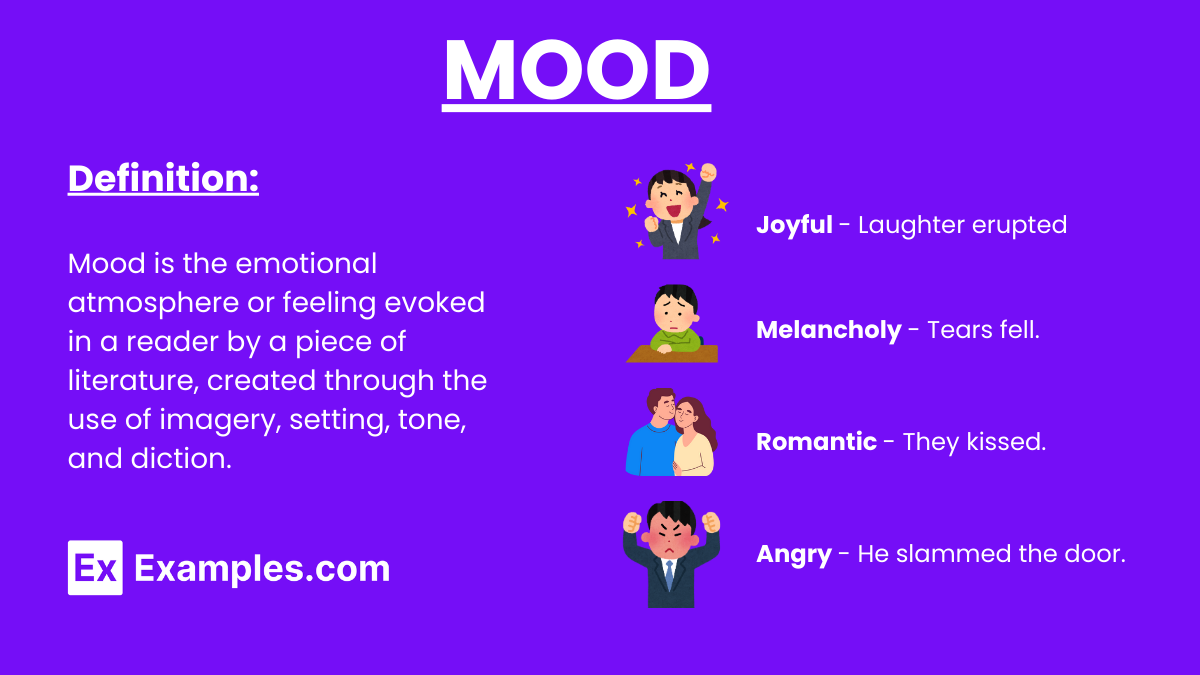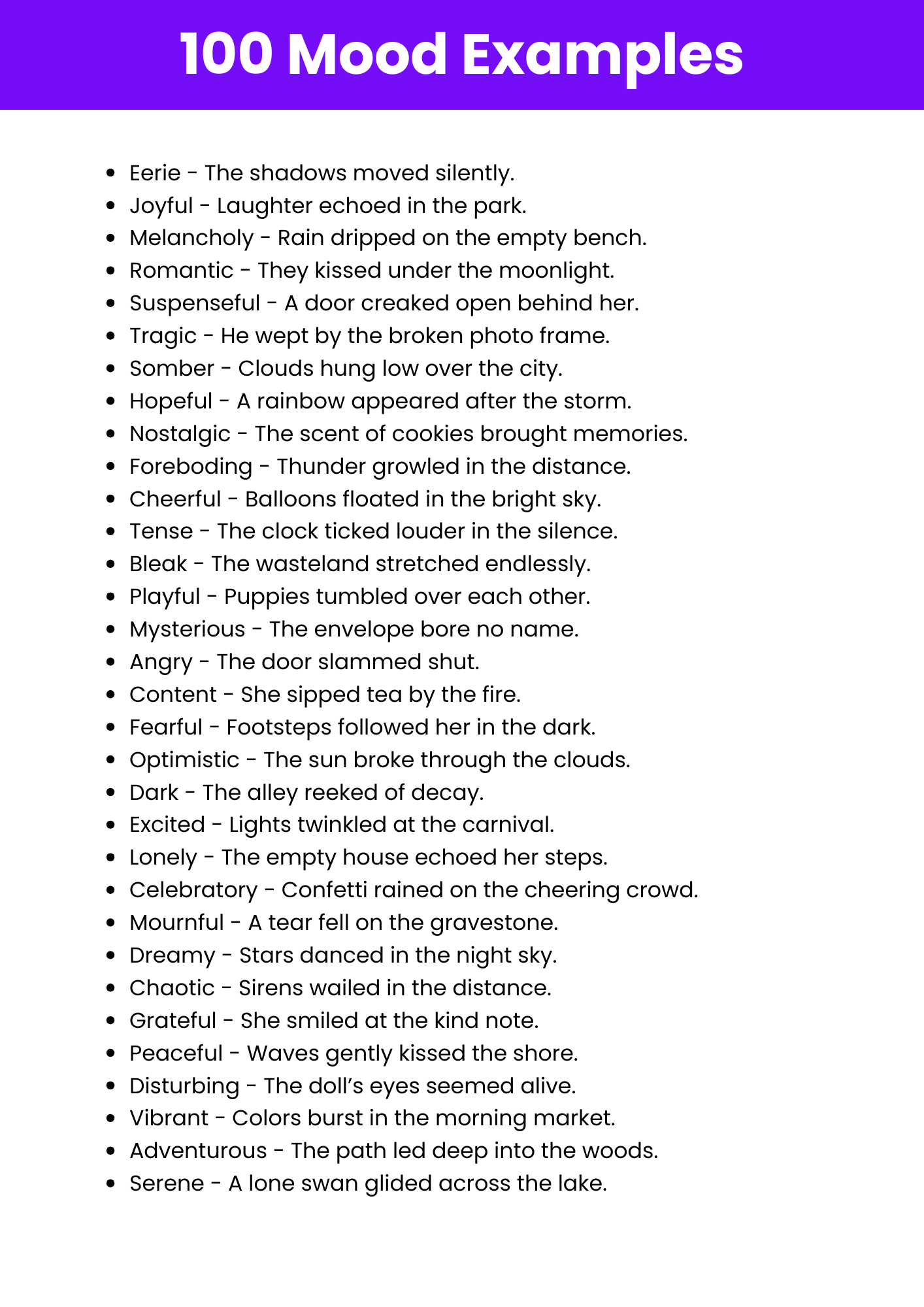Mood
What is Mood? – Definition
Mood refers to the emotional atmosphere or feeling evoked in the audience by a piece of writing, art, or experience, created through tone, setting, and descriptive language.

Generated Mood Examples

Download Mood Example Examples
Enhance your understanding with our comprehensive PDF guide.
Download PDFExamples of Moods
- The sun shone brightly, creating a cheerful atmosphere.
- Dark clouds loomed overhead, casting a gloomy shadow.
- The abandoned house felt eerie in the moonlight.
- The sudden thunderstorm created a tense mood.
- Raindrops pattered softly, evoking a melancholic feeling.
- The bright lights created a vibrant and lively scene.
- Celebrations filled the air with joy and excitement.
- The vast ocean inspired a sense of awe and wonder.
- The rugged mountains exuded a feeling of isolation.
- The sudden explosion created a chaotic and fearful mood.
- The playful puppies brought happiness to the room.
- The blazing fire created a warm and inviting atmosphere.
- Sunlight streaming through the windows gave a bright and hopeful mood.
- The intense heat of the fire instilled a sense of urgency.
- Overcast skies created a somber and reflective mood.
- The photograph captured a nostalgic and sentimental mood.
- The slow ticking of the clock emphasized the tense mood.
- The foggy landscape created an eerie and mysterious mood.
- The winding path through the forest evoked a contemplative mood.
- The vibrant sunrise symbolized hope and new beginnings.
- The old letters brought back a sentimental mood.
- The bustling city streets created a lively and energetic mood.
- The quiet library fostered a studious and focused mood.
- Her radiant smile brightened the room, creating a joyful mood.
- The gentle breeze brought a peaceful mood to the garden.
- The calm sea evoked a serene and tranquil mood.
- The sturdy oak tree provided a sense of stability and comfort.
- The distant lighthouse created a hopeful mood for the lost sailors.
- The dense forest evoked a mysterious and adventurous mood.
- The sudden explosion created a chaotic and fearful mood.
Types of Moods
Joyful Mood
A mood that conveys happiness, positivity, and delight.
- Dancing in the rain after a long drought.
- Hearing a child’s laughter echo in a park.
- Receiving an unexpected gift from a loved one.
- Watching the sunrise on a clear morning.
- A surprise party thrown by close friends.
Sad Mood
A mood that evokes feelings of sorrow, loss, or disappointment.
- Watching a wilted flower fall from its stem.
- Reading a letter from a loved one who is no longer around.
- Rain falling on a deserted playground.
- A farewell scene at an airport.
- A broken toy lying forgotten in the corner.
Peaceful Mood
A mood that radiates calmness, serenity, and harmony.
- Sitting by a quiet lake at sunset.
- Listening to the rustle of leaves on a breezy afternoon.
- Meditating in a candle-lit room.
- Watching waves gently lap the shore.
- A forest blanketed by soft snow.
Tense Mood
A mood that creates a feeling of anxiety, unease, or suspense.
- A creaking floorboard in a dark, silent house.
- The countdown before a rocket launch.
- A character hiding while footsteps approach.
- A storm building on the horizon as people scramble for shelter.
- The moment before an important exam begins.
Nostalgic Mood
A mood that stirs longing for the past, often with mixed emotions.
- Flipping through a dusty photo album of childhood memories.
- Walking through the hallways of an old school.
- The smell of baked goods that reminds you of your grandmother’s kitchen.
- Hearing an old favorite song on the radio.
- Revisiting a place you haven’t seen in years.
Romantic Mood
A mood filled with love, passion, and intimacy.
- A couple walking hand-in-hand under the moonlight.
- A bouquet of roses left on a doorstep with a handwritten note.
- Dancing with someone special at a candlelit dinner.
- Watching a sunset together on a secluded beach.
- Writing love letters by the fireplace.
Suspenseful Mood
A mood that keeps the audience on edge, anticipating what will happen next.
- A detective approaching a closed door in a crime scene.
- The protagonist’s heartbeat quickening as they hear footsteps behind them.
- A ticking bomb counting down the final seconds.
- A hand reaching out to turn a doorknob in a dark room.
- A sudden, sharp knock at the window during a thunderstorm.
Whimsical Mood
A playful, fanciful mood that evokes a sense of wonder and imagination.
- A trail of glitter leading to a mysterious door in the woods.
- Talking animals sharing a tea party.
- A rainbow stretching across the sky after an unexpected shower.
- A child building castles in the clouds.
- Floating lanterns lighting up a starry night sky.
How to Identify/Find Mood?
To identify Mood Examples, look for phrases that describe emotions or atmospheres by associating them with other elements without using “like” or “as”. Mood Examples often highlight similarities between different elements, creating a vivid image or conveying deeper feelings.
- Look for direct associations that imply one emotion or atmosphere through another element.
- Identify words or phrases that create strong visual or emotional imagery.
- Check if the association enhances the understanding of the emotion or atmosphere.
- Notice if the association adds emotional or descriptive depth.
- Look for Mood Examples that are integral to the theme or message.
How to Use Mood?
Use Mood to enhance your writing by making associations that reveal new insights or add emotional depth. Ensure your Moods are clear and relevant to the subject, avoiding mixed or clichéd expressions for greater impact.
- Choose associations that resonate with your audience.
- Use vivid and specific imagery to make your Mood stand out.
- Integrate Mood seamlessly into your narrative or argument.
- Ensure the Mood enhances the reader’s understanding or emotional response.
- Avoid overusing Mood to maintain their effectiveness.
Other Mood Examples
Mood Examples in Literature
Examples of mood in literature showcase how authors evoke emotions and set the tone for their stories.
- The foreboding mood in *Macbeth* as the witches deliver their prophecy.
- The hopeful mood in *The Alchemist* as Santiago pursues his dream.
- The melancholic mood in *Of Mice and Men* during George and Lennie’s struggles.
- The mysterious mood in *Rebecca* as the narrator explores Manderley.
- The adventurous mood in *Treasure Island* as Jim embarks on his quest.
Mood Examples in Poetry
Examples of mood in poetry capture the emotions and themes poets evoke through their words and imagery.
- The joyful mood in *I Wandered Lonely as a Cloud* by William Wordsworth.
- The somber mood in *Do Not Go Gentle into That Good Night* by Dylan Thomas.
- The nostalgic mood in *Fern Hill* by Dylan Thomas.
- The eerie mood in *The Listeners* by Walter de la Mare.
- The tranquil mood in *Leisure* by W. H. Davies.
Emotional Mood Examples
Emotional mood examples highlight how moods reflect and amplify human feelings in narratives.
- A mood of love in *Romeo and Juliet* during the balcony scene.
- A mood of tension in *The Hunger Games* during the reaping ceremony.
- A mood of sorrow in *The Book Thief* after Liesel loses her family.
- A mood of triumph in *Harry Potter and the Goblet of Fire* after Harry wins the Triwizard Tournament.
- A mood of curiosity in *Alice’s Adventures in Wonderland* as Alice explores Wonderland.
Positive Mood Examples
Positive mood examples reflect uplifting, cheerful, or inspiring emotions conveyed in various forms of storytelling.
- The joyful mood in *The Sound of Music* during the “Do-Re-Mi” song.
- The inspiring mood in *Dead Poets Society* as Mr. Keating motivates his students.
- The celebratory mood in *The Lion King* during Simba’s coronation.
- The magical mood in *Cinderella* when her fairy godmother transforms her attire.
- The peaceful mood in *Finding Nemo* during the scenes in the coral reef.
Mood Examples in Movies
Mood in movies sets the emotional tone and helps audiences connect with the story.
- The romantic mood in *Titanic* during Jack and Rose’s first dance.
- The ominous mood in *Jaws* as the shark’s fin surfaces.
- The celebratory mood in *Rocky* when Rocky runs up the steps of the Philadelphia Museum.
- The adventurous mood in *Indiana Jones and the Raiders of the Lost Ark* during the boulder chase scene.
- The somber mood in *Schindler’s List* during the scenes at Auschwitz.
Mood Examples in a Story
Mood in stories shapes readers’ emotional responses and enhances the narrative experience.
- The tense mood in *The Tell-Tale Heart* as the narrator hears the beating heart.
- The sorrowful mood in *Bridge to Terabithia* after Leslie’s death.
- The triumphant mood in *The Little Engine That Could* as the engine reaches the top of the hill.
- The nostalgic mood in *Where the Red Fern Grows* as Billy recalls his childhood.
- The hopeful mood in *Charlotte’s Web* as Wilbur’s life is saved.
Explore Other Literary Devices
Elevate Your AP English Preparation
Unlock your potential with our comprehensive AP English exam preparation tools designed to help you excel.
- Extensive Question Bank: Access 900+ exam-like questions for both AP English Language and Literature.
- Expertly Crafted: Questions mirror the structure and difficulty of actual AP exams, ensuring relevant practice.
- Detailed Explanations: Understand your mistakes with clear, concise breakdowns of correct and incorrect answers.
- Personalized Learning: Tailor your study sessions with topic-specific tests and adaptive learning tools.
- Comprehensive Coverage: Master all aspects of the AP English curriculum with extensive guides and resources.
Frequently Asked Questions
-
What is mood in literature?
Mood refers to the overall feeling or atmosphere that a reader experiences while reading a literary work. It is created through the author’s use of descriptive language, setting, and tone, influencing how the reader emotionally connects with the story. -
How does mood differ from tone?
While both mood and tone are related to the emotional aspects of a literary work, tone refers to the author’s attitude toward the subject or audience, whereas mood pertains to the emotional atmosphere experienced by the reader. In essence, tone is the author’s perspective, and mood is the reader’s emotional response. -
Why is mood important in storytelling?
Mood plays a crucial role in storytelling as it sets the emotional backdrop against which the narrative unfolds. It helps to engage readers, evoke specific feelings, and enhance the thematic depth of the story, making the experience more immersive and impactful. -
How can authors create mood in their writing?
Authors create mood through various literary devices such as descriptive imagery, sensory details, diction (word choice), setting, and the pacing of the narrative. By carefully selecting words and crafting scenes that evoke specific emotions, writers can manipulate the mood to align with the story’s themes and character developments. -
What are some examples of mood in literature?
Examples of mood in literature include:- Gloomy: “The dark clouds loomed over the deserted village, casting long shadows on the broken streets.”
- Joyful: “Sunlight streamed through the open windows, filling the room with warmth and laughter.”
- Suspenseful: “Every creak of the old house amplified her racing heartbeat as she tiptoed through the silent corridors.”
- Melancholic: “Autumn leaves drifted lazily to the ground, mirroring his waning hope.”
- Peaceful: “The gentle waves lapped against the shore, creating a soothing rhythm that calmed her restless mind.”

